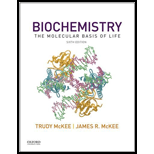
Concept explainers
To review:
The standard free energy for the following reactions:
Introduction:
Gibbs free energy is the potential that can be used for the calculation of maximum reversible work that is performed at constant temperature and pressure. The phosphoryl group transfer potential of a compound can be defined as ameasure of the strength of attachment of a group to amolecule. It usually refers to the differences in the standard free energies of the molecule with and without the group.
Explanation of Solution
According to the standard reduction potentials (E°’) given in table 9.1, E°’ of some
| Redox half-reaction | E°’ (in Volt or V) |
| |
|
| |
-0.32 |
| |
+0.235 |
The calculation of standard free energy for the following reactions is described below:
For calculating the standard free energy, the number of electrons transferred needs to be balanced. For a reaction, the standard free energy can be calculated by using the Nernst equation
Where,
n is the number of electrons transferred,
F is Faraday’s constant, which is 96.15 kJ/V.mol (kilojoule per Volt. mole) and
∆E°’ is overall cell potential.
∆E°’ can be calculated by the following formula:
In the given case, E°’ of electron acceptor is +0.82 V and that of electron donor is -0.32 V.
Putting the values of n, F, and ∆E°’ in the Nernst equation:
Thus, the standard free energy of the reaction is
In the given case, E°’ of the electron acceptor is +0.82 V and that of the electron donor is -0.235 V.
For a reaction, the standard free energy can be calculated by using the Nernst equation.
Putting the value of n, F, and ∆ E°’ in the Nernst equation:
Thus, the standard free energy of the reaction is
Thus, it can be concluded that the standard free energy of
Want to see more full solutions like this?
Chapter 9 Solutions
Biochemistry: The Molecular Basis of Life
- fill in the table and circle the active sitearrow_forwardThe two half reactions for beginning and end of the electron transport chain are given below in standard form. Calculate & for the overall process. Using the Nernst equation (AG° = -n Fo, F= 96.485 kJ/volt mol), calculate AG°. Explain the need for a stepwise process in the electron transport chain. NAD* + H+ + 2 e- = NADH ½ 0г + 2H+ + 2е- = H20 = -0.32v E = +0.82Varrow_forwardanswer the questions and the example steps should be from carbohydrates glycolysis and citric acid cycle. Please put down reactions and structuresarrow_forward
- identify the general type of reaction catalyzed and an example step from glycolisis structure for each of the following enzymes/ co factor Kinase, isomerase, mutase, dehydrogenase, NAD+ , FADarrow_forwardfill in the blanks with the missing structures and give namesarrow_forwardfill in the table and identify the general type of reaction catalayzed and an example step from the structures in the second page so you will answer the questions from the first page the second one is just a reference urgently!arrow_forward
- Please draw out the molecular structures of each molecule and show how each enzyme + cofactor would affect the following molecule in the human metabolic pathway. (This is a metabolic map)arrow_forwardPlease draw out the molecular structures of each molecule and show how an enzyme + cofactor would affect the following molecule in the human metabolic pathway to create energy.arrow_forwardPlease draw out the molecular structures of each molecule and show how each enzyme + cofactor would affect the following molecule in the human metabolic pathway.arrow_forward
- Please draw out the mechanism with curved arrows showing electron flow. Pyruvate is accepted into the TCA cycle by a “feeder” reaction using the pyruvate dehydrogenase complex, resulting in acetyl-CoA and CO2. Provide the mechanism for this reaction utilizing the TPP cofactor. Include the roles of all cofactors.arrow_forwardPyruvate is accepted into the TCA cycle by a “feeder” reaction using the pyruvate dehydrogenase complex, resulting in acetyl-CoA and CO2. Provide the mechanism for this reaction utilizing the TPP cofactor. Include the roles of all cofactors.arrow_forwardThe mitochondrial ATP synthase has 10 copies of the F0 subunit “c”, and the [H ] in the mitochondrial inner membrane space (IMS) is 6.31 x 10-8 M and the [H + ] in the matrix is 3.16 x 10-9 M. Calculate the minimum membrane potential (∆Ψ) necessary to make ATP synthesis thermodynamically favorable. [Assume ∆G' ofphosphate hydrolysis of ATP is - 45 kJ/mol.]arrow_forward
 Principles Of Radiographic Imaging: An Art And A ...Health & NutritionISBN:9781337711067Author:Richard R. Carlton, Arlene M. Adler, Vesna BalacPublisher:Cengage Learning
Principles Of Radiographic Imaging: An Art And A ...Health & NutritionISBN:9781337711067Author:Richard R. Carlton, Arlene M. Adler, Vesna BalacPublisher:Cengage Learning- Essentials of Pharmacology for Health ProfessionsNursingISBN:9781305441620Author:WOODROWPublisher:Cengage
 Anatomy & PhysiologyBiologyISBN:9781938168130Author:Kelly A. Young, James A. Wise, Peter DeSaix, Dean H. Kruse, Brandon Poe, Eddie Johnson, Jody E. Johnson, Oksana Korol, J. Gordon Betts, Mark WomblePublisher:OpenStax College
Anatomy & PhysiologyBiologyISBN:9781938168130Author:Kelly A. Young, James A. Wise, Peter DeSaix, Dean H. Kruse, Brandon Poe, Eddie Johnson, Jody E. Johnson, Oksana Korol, J. Gordon Betts, Mark WomblePublisher:OpenStax College





